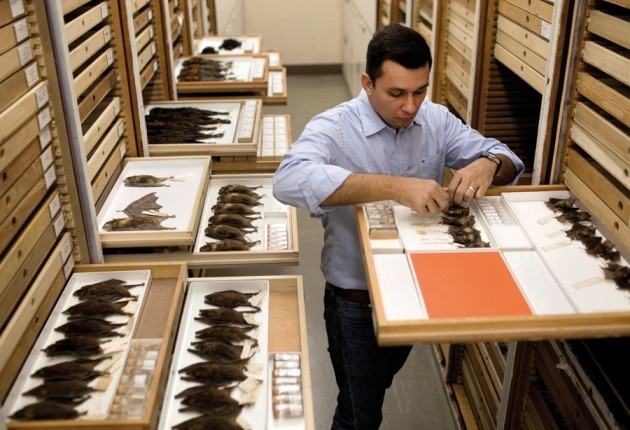
- Select a language for the TTS:
- UK English Female
- UK English Male
- US English Female
- US English Male
- Australian Female
- Australian Male
- Language selected: (auto detect) - EN
Play all audios:
More work needs to be done by the agricultural sector to get to the bottom of — and put a stop to — transmission of H5N1 bird flu in dairy cattle in the United States, a senior World Health
Organization official said over the weekend. Maria Van Kerkhove, the WHO’s acting director of epidemic and pandemic preparedness and prevention, said the world is watching how the U.S., with
its advanced scientific expertise, is responding to this outbreak. Since the spread in cows was first confirmed in late March, 207 herds in 14 states have tested positive for H5N1. This is
the first time the virus has been seen to spread in a mammalian species with which humans have frequent and close exposures. The outbreak raises concerns that a virus that is genetically
coded to infect wild birds will adapt to be able to more easily infect mammals like humans. Van Kerkhove, who oversees the WHO’s global influenza program, said better cooperation between
the animal health and human health sectors is needed to get a better handle on this situation, which has already led to 14 confirmed human cases of H5N1 infection in the U.S. this year. “We
need to see much more cross collaboration,” she said. There have been many reports of farmers refusing to test symptomatic animals, seeing no upside to having their operations labeled as
being part of the outbreak. Farmers have also been reluctant to allow Centers for Disease Control and Prevention personnel on their farms to test workers to look for additional cases. As a
consequence, there’s no sense of what portion of the animal or human infections is going undetected. Van Kerkhove spoke to STAT the day after the CDC revealed that a household contact of
the newest H5N1 case — a person in Missouri with no known exposure to animals — had been sick at the same time as the confirmed case. One of the individuals was hospitalized and tested
there; the second person recovered at home and was not tested. Blood tests — known as serology tests — could determine if the second individual was also infected, and if anyone else among
their contacts was infected, if the individuals agree to be tested. This transcript of the conversation with Van Kerkhove has been edited for length and clarity. USDA, FDA turf battles
hamper responses to outbreaks like H5N1 bird flu IS WHO CONCERNED ABOUT THE MISSOURI SITUATION? Of course we are concerned. For me, this case in Missouri is scientifically fascinating. The
person was infected somehow. It’s not a magical infection, and what I appreciate is that further work [is underway] to understand how this person and potentially people around this person
who had symptoms could have been infected. Serology is going to be really critical here. I’ve said that to the CDC. They think that as well, so I’m not saying anything that they don’t know.
The bigger question for me is about the animals around these individuals — so the wild birds, the poultry. I understand the last poultry positives were many, many months ago. IN MISSOURI,
YOU MEAN? Yeah. I’m not alarmed in the sense where I think something is happening, where we’re now seeing efficient human-to-human transmission. But what I need to see happening — speaking
as the person leading the work at WHO on epidemic and pandemic prevention and preparedness, leading on the global influenza program — is more efforts by the animal sector to really
understand what’s happening in animals. I think the cross-sectoral collaboration that’s happening in the U.S. is challenging on many different fronts. But this is the One Health approach
right in front of us. And if there are not investigations that take place when you have a detected case in humans — back tracing, forward tracing, looking at animal exposures, going to the
ministry of agriculture or the USDA, looking at wildlife, looking at poultry, looking at dairy cattle, looking at swine — then we don’t have a complete picture. That’s what concerns me, not
having that complete picture. I am very grateful for what the U.S. is able to do, the capacities that the U.S. has to be able to sequence and pull out a partial [genetic] sequence. That’s
pretty … I’m going to use the word magical. I BELIEVE THE CDC WORKED VERY HARD TO GET THOSE PARTIAL SEQUENCES. Yeah, they did. And that’s good. I’d be more concerned if we start to see
changes in the virus. If we start to see chains of transmission. We have seen [in other countries] in the past very limited human-to-human transmission. That wouldn’t surprise me. What is
more concerning to me at the moment is the ability for sectors to work closely with each other. GETTING FARMWORKERS TO USE PPE IS HARD, BUT IT’S THE BEST WAY TO STOP AN H5N1 BIRD FLU
EPIDEMIC YOU SAID YOU WANT TO SEE SEROLOGY DONE IN MISSOURI. BUT ON FRIDAY THE MISSOURI DEPARTMENT OF HEALTH AND SENIOR SERVICES SAID SEROLOGY “IS BEING CONSIDERED.” I would strongly
encourage that serology to be conducted. I just think the world looks to the United States to demonstrate what to do. There are such capabilities. There are incredible scientists. I’m
talking with them every single day and I am grateful for the work they do. There’s certainly a frustration about the ability to work across sectors, and I think everybody wants that to
improve. As WHO, we work really closely with the World Organization for Animal Health, with the Food and Agriculture Organization to really try to beef up — sorry for the pun there — to
improve surveillance in animal populations. But if we don’t have that, there’s an element of not having complete visibility. MISSOURI HASN’T REPORTED ANY POSITIVE HERDS. DOES THAT MEAN THEY
HAVE NONE? WHO KNOWS? What I would like to see across the globe, including in the United States, is the results of negative tests. We only get positives. Knowing who’s testing and what’s
negative is just as important as the positives right now. IF YOU’RE NOT DOING ANY TESTING, THEN YOU DON’T EVEN HAVE NEGATIVE RESULTS. Well, if you’re not doing testing, then you don’t know.
We’re piecing together clues from bits and pieces of information, and I think there’s much more that can be done to fill in those holes. The question is, why is it not being done? And how
can we support it being done? I understand resources are not infinite. But if we really want to get to the bottom of what’s happening — especially for this case, detected without any animal
exposure — I think it’s important to follow up. The really important question for me is not only knowing how this individual was infected, or the extent of infection around this individual,
but are there any changes in the virus? Are we seeing something different? I don’t believe that fundamentally something has changed in terms of the virus, in terms of its transmissibility.
But my ability to say that is dependent upon what I know and dependent upon [the information that] is in the pipeline. So I would like there to be more in the pipeline in terms of those
clues to help us disentangle this. If we don’t address the incentives and disincentives for dealing with the drivers of spillovers, which include politics, which include financial
incentives, which include trade, which include food security, then I think we’re going to continue to struggle to deal with these types of zoonotic viruses. I’VE BEEN INTERESTED TO SEE
WHAT’S HAPPENING IN CALIFORNIA. THEIR APPROACH IS KIND OF AGGRESSIVE IN A TARGETED WAY…. Aggressive in a targeted way? LET ME PUT IT THIS WAY: IT’S NOT PASSIVE. THEY ARE DOING MANDATORY BULK
TANK TESTING WITHIN SIX MILES OF ANY AFFECTED OPERATION, AND THEY’RE GOING OVER THE BOOKS OF THOSE OPERATIONS. SO IF FARM X THAT IS INFECTED IS OWNED BY A COMPANY THAT OWNS FARM Y AND Z
TOO, THEY’RE TESTING THOSE AS WELL. AND THEY’RE LOOKING AT RECORDS OF CATTLE MOVEMENTS AND WORKER MOVEMENTS. I think that’s smart. Looking at things with some level of precision, based on
risk, based on a strategy of what are you trying to accomplish here, I think should be applauded. But I think from a farm biosecurity sense, there’s a lot [more] that can be done. It keeps
the animals safe. It has further protection in terms of limiting spread. We need to look at the financial incentive for this. And that’s a big, big challenge. NEW STUDY SPARKS DEBATE ABOUT
WHETHER H5N1 VIRUS IN COWS IS ADAPTED TO BETTER INFECT HUMANS I THINK THIS IS ONE OF THE MOST INSIDIOUS THINGS H5N1 HAS DONE, INFECTING A MAMMALIAN SPECIES WITHOUT CAUSING IT SEVERE DISEASE.
IT REMOVES THE INCENTIVE TO TRY TO CONTAIN IT. Look at MERS. [It] infects dromedary camels causing no symptoms at all. This has been the whole challenge. Why would you tackle this
particular virus in an animal species where there’s absolutely [no risk to the animal]? We have witnessed a massive epizootic of avian influenza in the last four or five years. The spread in
the wild birds, in poultry, in marine mammals, land mammals. This should not be a surprise. I think the surprise for me is a highly capable country that has incredible scientists across
multiple sectors, what they are trying to do to tackle this. Because the world is watching. And they know that they can do more. Our relationship with the U.S. — with Health and Human
Services, CDC, the National Institutes of Health — on the human health side is really strong. We have these conversations all the time. I think what we need to see is more on the animal
sector. We need to see much more cross collaboration. My worry in saying this to you right now is the blame game. You know, ‘The human health [side] does this’ and ‘The animal health [side]
does this.’ But for me, if we’re actually in this together, then we need to really collectively do more to address this together. I don’t question the will. I do not question the USDA by any
means. I’m questioning what it is that is prohibiting animal and human health sectors globally to work more cohesively together. I think more can be done.







